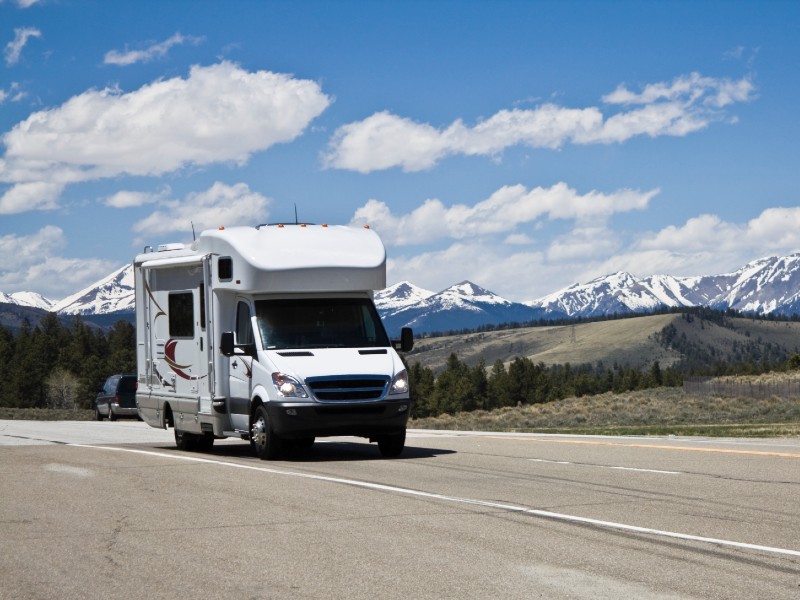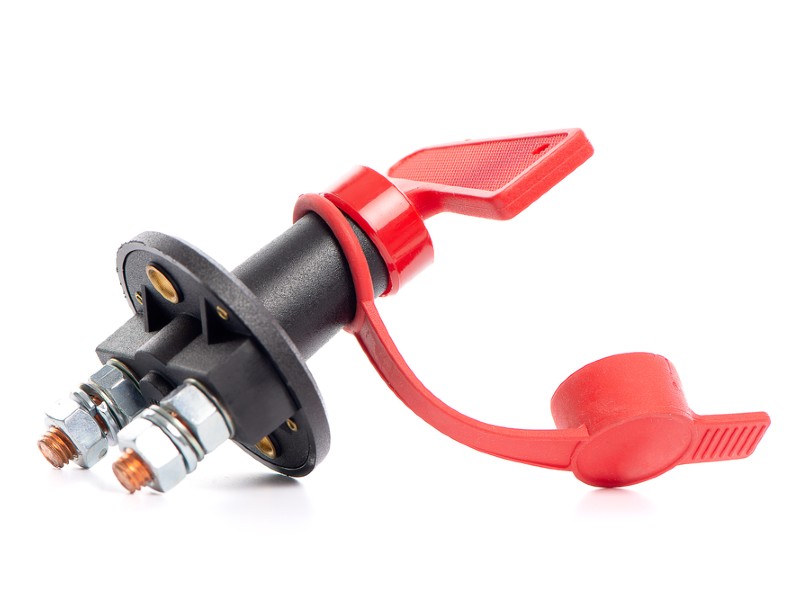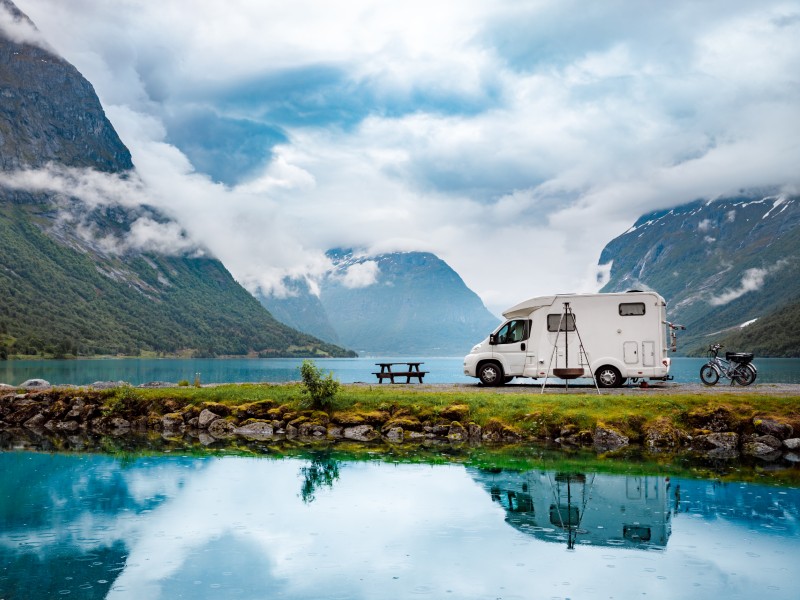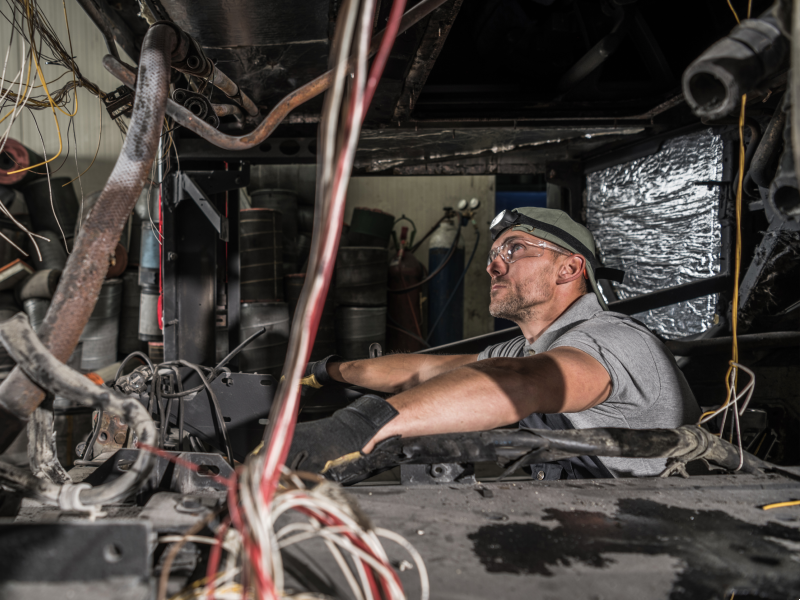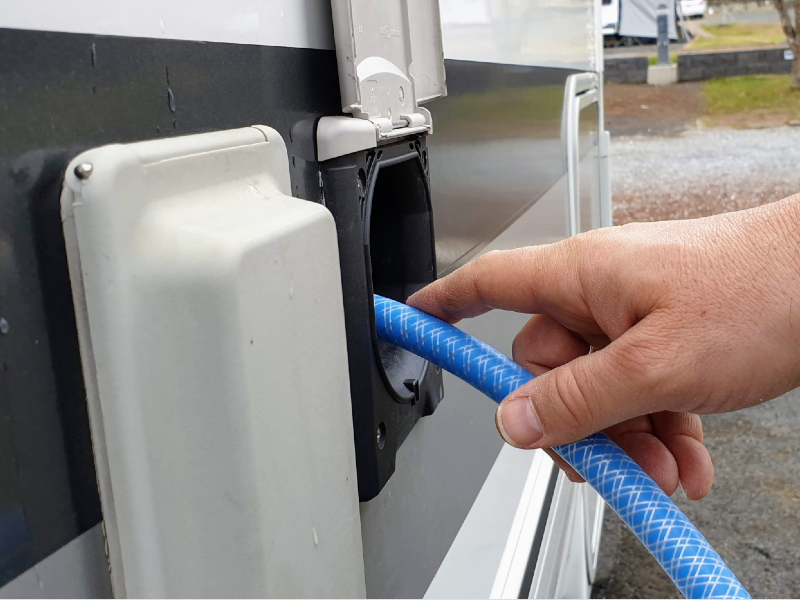You’re all packed up to go on a month-long excursion with your family. Traveling across the country in an RV has always been your dream.
But wait, something is dripping underneath the kitchen sink. You open up the cabinet to find a huge puddle of water and rotted flooring from continued water seepage.
How do you keep your dream vacation from becoming another trip to the repair shop?
All RV owners will experience their fair share of woes. Preparing for the most common RV problems is key to reducing damage and costly repairs.
A Comprehensive List of Common Interior Issues
Electrical Repairs
When every aspect of your RV — from side slide-outs to TVs to lights — is powered by electrical circuits, it’s easy for one small issue to take out several sources of power.
Typically, replacing push buttons or switches in an RV circuit box is a very easy procedure. This RV problem is more common than you think. However, if you have no experience dealing with electricity or wiring, now is the time to seek help from a professional.
This is no task to mess around with.
Common malfunctions result from the typical clip-together receptacles that motorhome manufacturers use. While cost-effective, these receptacles are also prone to coming loose, especially in a vehicle that is constantly moving.
These can easily be replaced with an outlet box that is similar to the type used in many homes. It is an easy fix that ultimately results in a more reliable source of power.
Learn about the Electrical System on Your RV (Video)
RV Toilet Issues
When you have to go, you have to go. When you experience a broken RV toilet, it’s disheartening.
Luckily, many toilet RV problems are common and simple enough to troubleshoot without professional help.
Too much toilet paper or too little water are common potty conundrums that can put a damper on a camping trip. Specialty toilet paper that can be found at big box stores or specialty camping stores can work wonders.
Another common toilet problem involves a user who leaves the black water drain pipe open continuously when hooked up to a sewer connection. This can be resolved by running a drain snake through the line from the exterior of the RV.
Commercial clogging remedies, such as DRANO, are unlikely to help in these situations and can actually make it worse. Sometimes the clog is so bad that an RV owner may need additional help from a trained professional.
Gaskets and valves must also be checked frequently and replaced as needed. Valves wear out with time, as do gaskets.
While they both take time to fix, replacing either of these items is not an impossible task.
Common RV Toilet Issues (Video)
Leaking Interior Pipes
Sinks, toilets, and refrigerators are the most common RV problems for leaky pipes. Oftentimes, over-tightening of PVC or flex pipe is the source.
Corrosion in older-style metal fixtures can also occur. Removing and replacing pipe fixtures is always an option and can be performed by even the most novice RV owners.
Winterizing your RV is also essential in the cooler fall and winter months. Antifreeze that is made specifically for RVs can be pumped through the entire system of your rig to minimize the chance of pipe freezing and cracking.
Broken water pumps and burst lines can cause extensive damage throughout your RV, especially if they are not detected early.
RV Plumbing Leak Diagnosis and Repair (Video)
HVAC Havoc
This is another common RV problem here.
Nobody wants to be stuck in a hot RV in the middle of July with an HVAC unit that is on the fritz. Air conditioning is necessary during the summertime and depending on the climate.
Many RV HVAC units are easy enough for an owner to repair and are low in cost.
Air vent replacements that can help with reduced airflow and broken thermostats that can be replaced are typical issues that can be easily repaired. The worst-case scenario might include a total air conditioner replacement.
Though it may sound daunting, replacing an RV air conditioner unit can actually be a DIY process that is easier than it sounds. Though it is the most costly option, due to the cost of the unit, your air would be blowing cold in no time.
Check Your RV Air Conditioner Immediately (Video)
RV Lights
While similar to light bulbs in your own home, replacing lights in an RV is a simple task. This problem occurs frequently and is a quick fix as long you have the correct type of light available.
Turning off the power source (often a switch), unscrewing the old light, and putting in a replacement are easy enough. Make sure you always have extra bulbs on hand, especially if you are camping in a remote area.
If replacing the bulb doesn’t solve your issue, check to ensure the new bulb is in good condition. More serious electrical problems may be at play if you still can’t get power to your RV lights.
RV LED Light Replacement | Useful Knowledge (Video)
Rodent Habitation
Probably one of the grossest topics to discuss is the potential for rodents or pests to make their new home in your RV.
During the winter months or periods when your RV is not being used, it is not uncommon for rodents and pests to move on in. Once inside your RV, they can quickly destroy textiles, laminate, carpet, and virtually anything they see as food.
Preparing your RV for these periods can help decrease the likelihood that you will experience pest problems. A proper cover (preferably indoors), good seals, and pest deterrents can help.
Mothballs for pests, Decon for mice, and various essential oils can keep pests at bay.
In severe cases, an exterminator would be able to offer advice on severe infestations. Pests and rodents can take over quickly, so the key is catching them before they become too difficult to eliminate.
How to Mouse Proof Your RV (Video)
Common RV Exterior Problems That Can Get You Down
Roof Leaks
Water leaks are virtually inevitable for RVs. Combine a portable vehicle that is made out of lightweight material that is expected to be used as living quarters, and you have a recipe for disaster.
Unlike a house, the roof of an RV is comprised of a material that is similar to the sides of the unit. Outdoor elements can take a toll on your RVs roof. Even the most well-made models are prone to cracking.
This can lead to interior water damage, mold development, and moisture damage to electronic components.
Common remedies for roof leakage include temporary sealant, roof re-surfacing, and perhaps a new roof purchase for serious cases. When caught early, roof sealants will generally do the job.
However, when exposure to moisture is prolonged, the consequences can intensify.
Prevention is key. Parking your RV under a waterproof, UV-resistant cover is optimal. However, a durable RV cover will suffice if that is all you have access to. Apply a roof sealant once a year in order to prevent small leaks from turning into large ones.
Also, check for leaks frequently, even when your RV is in storage.
Slide Out Concerns
Rust, corrosion, and general wear and tear can leave slide-outs in a less-than-optimal condition. Though slide-outs do provide much-needed extra space in many newer RVs, the technical problems that coincide can be unpleasant.
As with most other RV parts, regular maintenance is essential for avoiding slide-out issues. When this fails, simple remedies can be helpful.
This might include using WD-40 for sticking parts or UV Resistant 303 to lubricate seals and keep them moist.
Yet, one common problem with slide-outs is leaks. With so many moving parts, water will surely find its way into your RV via this entry route.
Good seals are ideal, which require frequent replacement and maintenance.
Explore the Great Outdoors with Us!
RV Windows, Seals, and Seams
Another prime point of water entry is the same surface that allows light to enter your RV: windows. Keeping windows closed, especially when it is damp or raining, can reduce water damage and resulting mold and mildew.
Windows can also be prone to cracking, chipping, and damaged sealants. Constantly jostling from RV operation are common problems that can cause even the best quality windows to become loose and sealants to crack.
Replacing or resealing RV windows is generally pretty easy. Always be sure to measure the window a bit larger than what you think to be necessary.
It is always easier to trim down a window than to have to invest in a new piece of glass because it gets cut too small. A new window, screwdriver, some good RV sealant, and some assistance are typically all you need.
Awnings and Canopies
Due to their transient nature, awnings and canopies are susceptible to damage by weather, storms, or moving components. Routine cleaning, careful retraction, and maintenance can help keep your canopy in tip-top shape.
Lights in modern awnings are prone to electrical issues and may be more costly to fix. Many types of awnings and canopies that are available with newer campers offer slide-out features and can be equipped with lights, speakers, and other electronic features.
While canopies are more costly to replace, it is virtually very easy to replace the entire structure. An awning or canopy is not something you want to go camping without, especially during the heat of the summer.
So, invest in this RV feature. You won’t regret it.
Battery Failure
Certain components of your RV run off of a battery all of the time, while others only operate via battery when they are not hooked up to a source of electricity. As you can imagine, batteries do frequently die.
When they do, purchasing and installing a new one is a simple task. Having a spare battery is ideal.
Disconnecting battery cables when the RV is not in use will keep the RV from drawing power when it is not in use. Checking the fluid level in the battery frequently and adding distilled water when necessary can help prolong the life of your RV battery.
Animal Collisions
Wild animals are frequently seen in remote camping areas crossing the road and roaming about. Hitting a deer, bird, or another large animal can severely damage the exterior of your RV.
The best course of action to mitigate losses such as these is to purchase RV insurance. While you may be able to make minor repairs, RV body repair can be time-consuming and costly.
It’s usually best left to the professionals. With adequate insurance coverage, you can pay your deductible and be on your way to the next campsite in no time.
Common RV Mechanical Problems That Will Make You Glow with Anger
RV Brakes
Such a heavy load requires frequent and quick stopping. Good, working brakes are crucial for your safety, your passengers, and your rig.
Brake components break down over time. Regular maintenance is required in order to keep your RV in road-worthy condition.
Refilling brake fluid and replacing parts timely, such as rotors and drums, can help ensure that your ride stops quickly and safely when needed.
All you need is a heavy jack, good assistance, and a few hours.
Tires
Many owners fail to recognize RVs as vehicles that require routine, proactive maintenance.
Frequently checking tire pressure, replacing cracking tires, and measuring tread on your RV’s tires will help keep your family safe when embarking on an adventure.
Poorly kept or bumpy roads can be hard on your tires. Unfortunately, these are the type of roads that RVs are typically driven on.
You will inevitably experience a flat tire at some point in time. Fear not. Replacing a flat tire can be done by owners or mechanics, as can complete tire rotations or new tire installation.
Make sure that you always have a spare tire that fits your RV because if a common problem occurs, you’re safe. When you experience a blowout, pull over immediately for repair.
Do not keep driving your RV, as this will cause more severe damage than the initial blowout. Also, keep in mind that most RV tires are more costly than vehicle tires, so prepare for that expense before it occurs.
Engine Trouble
Similar to a common persona vehicle, RVs are highly susceptible to engine problems. With the mileage that most owners put on RVs, it is no wonder that a breakdown is inevitable.
Keep a roadside assistance kit with you on every trip. With a small tool kit, most RVs can be fixed well enough to get them to the next service facility.
Also, keeping a schematic diagram of your RV’s specific engine may also be helpful in making temporary repairs.
In many instances, engine repairs may be covered by outstanding warranties. Roadside assistance and towing may also be offered by your insurance company.
Keep these options in mind when you are dealing with an RV breakdown.
User-Created Problems
Let’s face it: accidents are out there waiting to occur. You put your slide out in without moving a large item out of the way.
You back your camper into a large branch while trying to get into the campsite. It can happen.
The best you can do is to be prepared for the most serious of accidents that could put an end to your camping trip.
Keeping a list of local RV repair shops, RV supply stores, and local resources can help if your family should find themselves in need of immediate repair services. Keeping a list of these areas will help big time when you have an issue with common RV problems!
Although RV problems are never pleasant when they occur, they often create memories that will never be forgotten.
In the face of disaster, stay level-headed, review your available options, and when all else fails, laugh it off. After all, the best memories are not made under boring circumstances.
5 Common RV Problems and How to Fix Them (Video)
Related Questions
- What are some preventative measures to avoid common RV electrical problems?
Regularly inspect your RV’s electrical system, including power cords, converters, inverters, batteries, and fuses, for any damage or wear and promptly replace any faulty components.
Additionally, avoid overloading your system by managing power usage carefully, using surge protectors to guard against voltage spikes, and ensuring proper grounding to prevent electrical shocks.
- How can one effectively troubleshoot common RV toilet issues while on a trip?
One can effectively troubleshoot common RV toilet issues by first identifying the problem, such as blockages or leaks, and then using appropriate tools like a plunger, leak repair kit, or specialized RV toilet chemicals for clogs.
It’s also crucial to understand your RV’s toilet system, have a basic tool kit handy, and know when to seek professional help if the issue is complex or persists.
- What are some tips for maintaining the HVAC system in an RV to prevent common issues?
Regularly clean and replace filters, as clogged filters can strain the system and reduce efficiency.
Ensure that the system undergoes professional inspections annually to catch any potential issues early and maintain the integrity of the seals to prevent air leaks.
- What are the best practices for preventing rodent habitation in an RV during the winter months?
To prevent rodent habitation in an RV during winter months, it is crucial to thoroughly seal all potential entry points such as pipes, vents, and gaps, and remove all food sources to make the environment less appealing.
Regularly checking and maintaining your RV, using rodent repellents, and storing your RV in a clean, secure location can also significantly minimize the chances of infestation.
- What steps can be taken to prevent and repair common roof leaks in an RV?
To prevent roof leaks in an RV, it’s important to regularly inspect the roof for damages, maintain seals around vents, skylights, and AC units, and use a quality RV roof sealant or coating.
If a leak occurs, identify the source of the leak, thoroughly clean the affected area, and then repair it using a patching material or a sealant specifically designed for RV roofs.
"Of all the paths you take in life, make sure a few of them are dirt."
-- John Muir
